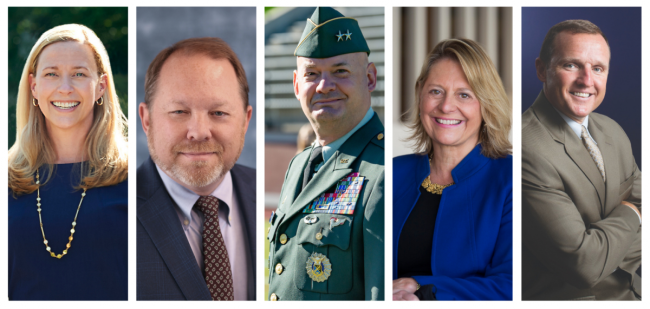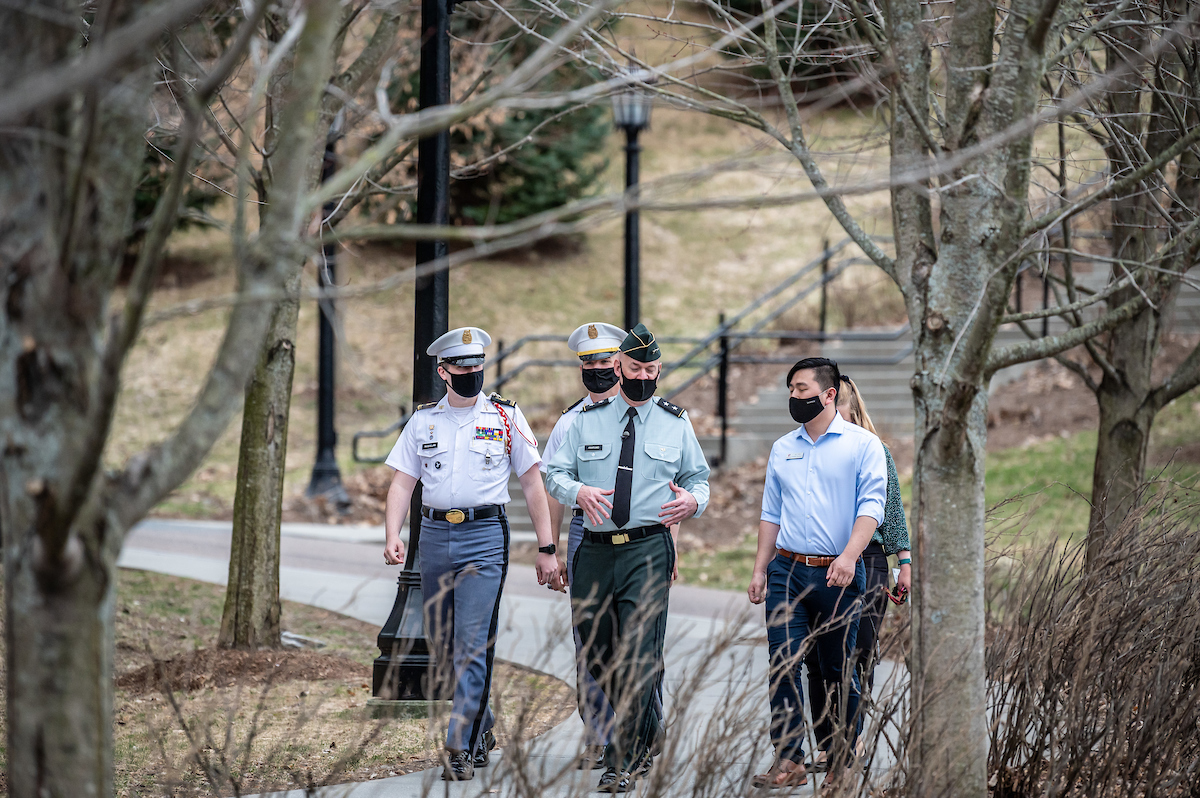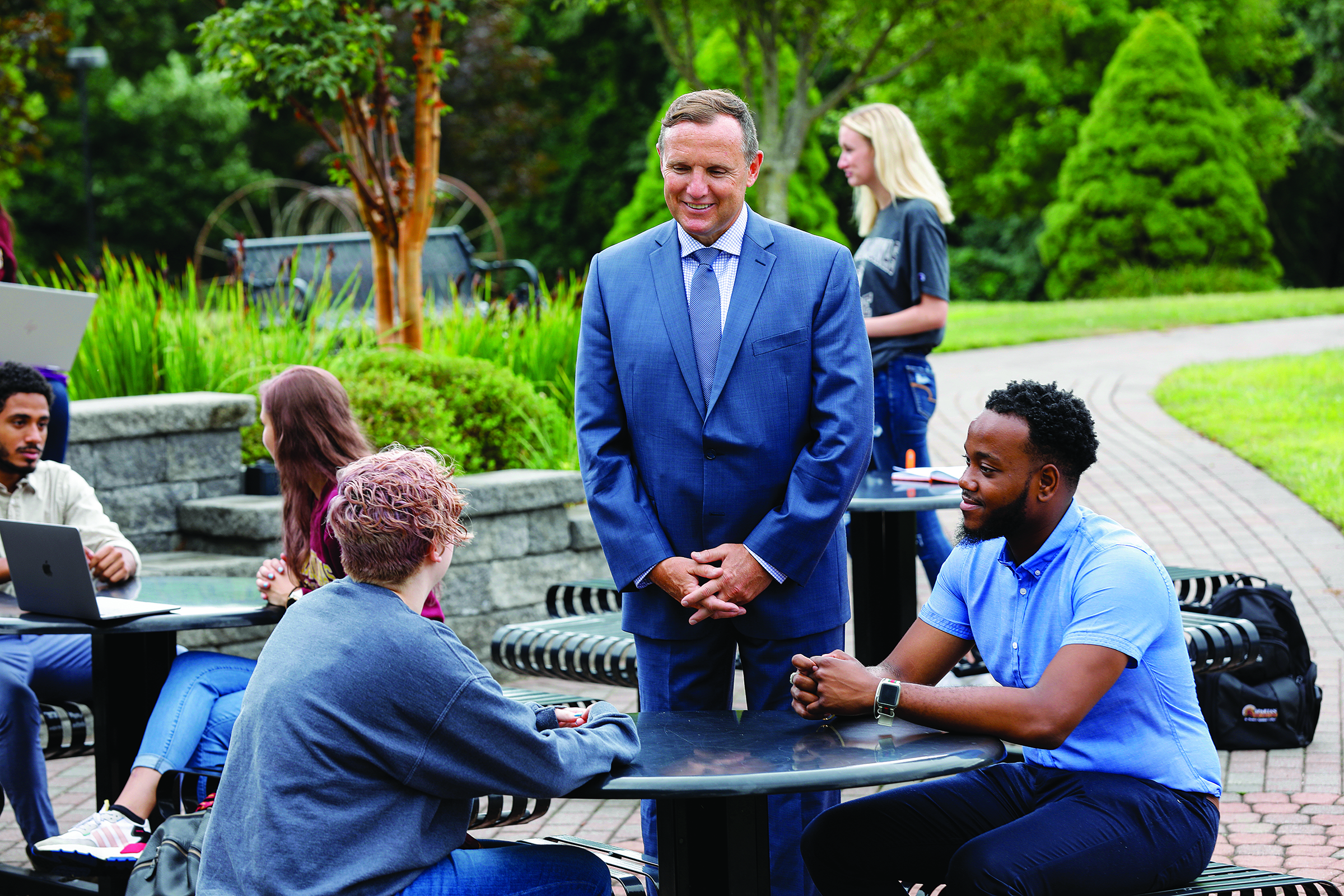You have /5 articles left.
Sign up for a free account or log in.

From left to right: Maurie McInnis, Bentley Wallace, Mark Anarumo, Laura Walker and Kenneth Daly
Courtesy of Stony Brook University, Bentley Wallace, Mark Collier/Norwich University, Bennington College and St. Thomas Aquinas College
When Bentley Wallace became president of South Arkansas Community College in February of last year, he planned to embark on a listening tour that would connect him with faculty and staff members, students, community members, and elected officials in the college's home of El Dorado, Ark.
He and his wife, Darby, were eager to get to know their new home after moving 120 miles south from North Little Rock, Ark. Wallace has years of experience at community colleges in Arkansas, but he’d never been a college president before. However, his priorities for the small public, two-year college quickly shifted last spring to focus on managing the COVID-19 pandemic.
“I had this grand vision of what the first 100 days might look like,” Wallace said. “Then it all came tumbling down with the pandemic. My experience went from the uncertainty about what I was supposed to be doing to the uncertainty of what we were all going to do.”
Keeping students and employees safe and their institution afloat through the past year was the top priority for most first-year college presidents who stepped into their roles right before or during the COVID-19 pandemic.
Retired U.S. Air Force colonel Mark Anarumo, president of Norwich University, a military college in Northfield, Vt., said he also put his goals for the university on the back burner. So did Laura Walker, president of Bennington College in Vermont; Kenneth Daly, president of St. Thomas Aquinas College in Sparkill, N.Y.; and Maurie McInnis, president of Stony Brook University in New York. Each stepped into their respective presidencies between February and August of last year.
“I had things I really wanted to do in my first year, and it really just became survival mode,” Anarumo said. “It was not time for me to bring in change, because it would have been too disruptive.”
Though no two institutions’ responses to the pandemic were exactly alike, the five first-year presidents’ experiences were quite similar. All five had to get to know their colleagues and students through video chats or socially distant meetups. They had to pour money into COVID-19 prevention efforts and weather unexpected revenue losses while getting to know their institutions’ financial histories. And their success may be judged using the same yardstick: How well did they handle the COVID-19 pandemic?
Getting Acquainted
Anarumo took over Norwich, the oldest private military college in the United States, when Richard Schneider retired in May 2020 after 28 years as president. Schneider was well-liked, and being the new guy was a bit intimidating, Anarumo said.
“With that level of longevity and adoration -- very well-deserved adoration -- it was difficult to follow that,” he said. “There was the discomfort that’s natural to that length of an incumbent.”
 Daly became president of St. Thomas Aquinas on the heels of Margaret Fitzpatrick, who had spent a quarter of a century at the institution.
Daly became president of St. Thomas Aquinas on the heels of Margaret Fitzpatrick, who had spent a quarter of a century at the institution.
For both new presidents, collaboration with their predecessors helped smooth the transition. For months prior to taking up the presidency, Daly worked with Fitzpatrick on future planning for the college.
“She led on the day to day, and I led on the future, since I’d be inheriting it,” Daly said. “That allowed me -- on July 1 at 7 in the morning -- to really hit the ground running.”
The next challenge for all five presidents was getting to know students, colleagues and board members.
McInnis, who started at Stony Brook July 1, tried to say yes to as many opportunities to meet safely with students and employees as she could during the first year of her presidency. She and her team held virtual town halls, outdoor small group meetings and dozens of videoconference calls. They sent plenty of emails to students, employees and parents.
“We tried to find that right balance between overcommunicating and not communicating enough,” she said.
Anarumo learned that different groups prefer different communication channels. Employees liked emailed memos best, while students and parents appreciated five- to six-minute video vignettes he recorded on his phone.
Some of those videos were recorded from a dorm room in Wilson Hall, where Anarumo lived for a couple of weeks in late January. He moved into the dormitory to quarantine with students at the beginning of the spring term. From his dorm room, he ate boxed meals, chatted with students in the bathrooms and hallways, and posted occasional video updates about his experience in quarantine.
His few weeks in Norwich dormitories were a morale boost for campus, he said. Within three weeks, the number of active COVID-19 cases at Norwich fell from 89 to zero.
“It let me really feel what they needed to be successful and valued and supported,” Anarumo said.
At Bennington, Walker recently became fully vaccinated, meaning that two weeks have passed since she received the second dose of a COVID-19 vaccine. Her past year has looked a lot like those of her fellow first-year presidents, and she was excited to be able to start meeting colleagues face-to-face. Walker quickly held an in-person meeting with donors and met several board members she’d never seen in person before.
“We were joking, saying, ‘How tall are you?’ It’s very bizarre,” Walker said. “Having a conversation around tea in a board member’s apartment where we were doing a give-and-take was so rewarding and enlightening.”
 In an attempt to replicate the connections usually made in an on-campus restaurant or faculty lounge, Wallace started a general videoconference meeting for all South Arkansas employees on Fridays at 8:15 a.m. Despite the early start time, an average of 75 faculty and staff members have logged on each week to share what they’re up to and hear from colleagues.
In an attempt to replicate the connections usually made in an on-campus restaurant or faculty lounge, Wallace started a general videoconference meeting for all South Arkansas employees on Fridays at 8:15 a.m. Despite the early start time, an average of 75 faculty and staff members have logged on each week to share what they’re up to and hear from colleagues.
Videoconference calls and socially distant small groups will never adequately replace in-person connections, Wallace said. Even after a year as president, he worries he won't be able to recognize the people he works with right away.
“I only recognize these folks when they have their mask on,” Wallace said. “As people are getting vaccinated and we’re starting to have in-person meetings again, and masks are coming off, I don’t readily recognize people by their face.”
Tough Financial Decisions
Most colleges and universities felt at least some financial pressure as a result of the pandemic, and leaders often had to quickly decide to dedicate resources to COVID-19 prevention efforts or online learning in order to keep institutions open.
As Walker and her team worked to put together a budget for the upcoming academic year, they factored in student deferrals, lost room and board revenue, additional technology costs for online learning, and weekly COVID-19 testing expenses.
"There was a lot of uncertainty with what to even put in a budget," Walker said. "Usually, budgets get adopted by the board before the beginning of the fiscal year, but there was so much uncertainty that we had, over the summer, to redo and rethink it."
McInnis felt the financial impacts of the pandemic twofold. When she started, Stony Brook was losing room and board revenue, enrolled fewer international students than in the past, and was preparing to pay for widespread COVID-19 testing. And while the university was bleeding funds, so were its hospitals.
McInnis also oversees Stony Brook Medicine, which encompasses five health sciences schools, three hospitals and 120 community-based health-care settings. Last spring, New York hospitals quickly pivoted to treating patients with COVID-19 during the first wave of infections throughout the state. Elective procedures and many primary care visits, which are more lucrative for the hospitals than COVID-19 treatment, were suspended.
“That was bad,” McInnis said. “That revenue was lost, and there’s no making that up.”
Stony Brook's financial outlook is more positive after the New York State Legislature kept funding flat for the State University of New York system this academic year. For a while last summer, the state contemplated a 20 percent to 30 percent budget cut for the system, McInnis said.
On top of pandemic-related budget stressors, St. Thomas Aquinas is preparing for an upcoming expected decline in the number of college-going students.
 “We’re directly feeling the competitive threat of the changing demographics,” Daly said. “Fewer high school students, more difficult ability for families to pay for college education. And then the COVID impact -- real dislocation in terms of students losing their jobs or families losing their jobs.”
“We’re directly feeling the competitive threat of the changing demographics,” Daly said. “Fewer high school students, more difficult ability for families to pay for college education. And then the COVID impact -- real dislocation in terms of students losing their jobs or families losing their jobs.”
To better position itself in the market, St. Thomas Aquinas built new dormitories and purchased 12 acres across the street from its current campus. The new land is called Camp Venture and will provide space for future growth. While the capital projects were part of a long-term plan, the university was helped by low interest rates and very high equity in a high stock market, Daly said.
All five presidents were proud of the way they handled their first years and were looking forward to the fall semester, when spending more time with colleagues and students could be possible. Looking back on the year, Anarumo pointed to one change he would have made.
“I would have adhered to the most pessimistic models more aggressively,” Anarumo said. “I don’t think anyone expected it to be as challenging as it would be.”
Several retiring presidents have said this year that the COVID-19 pandemic has been the most challenging part of their careers. McInnis said she hopes that's true for her as well. So does Wallace.
"It was a trial by fire, and so I hope that I'm better prepared to handle whatever comes next," Wallace said. "There will be other issues, there will be other problems, but hopefully not this global. The thing about this one was it wasn't something we could fix locally. We just had to ride the wave."




